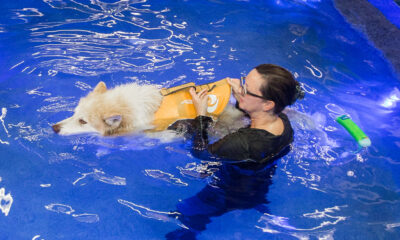We are lucky enough at Water4Dogs to have both an indoor pool and two underwater treadmills to use with our patients! Hydrotherapy, which may include one or both of the above listed treatments, is a wonderful low impact way to reach your rehabilitation goals. Water resistance greatly challenges muscle tension and strength, while buoyancy of the heated water allows significant offloading of pressure on the joints and improved flexibility of tissues.
The Underwater Treadmill is a device which has a traditional treadmill belt inside of a rectangular watertight tank. This tank will slowly fill from the base up until the ideal depth is reached by the treating therapist. Our sessions are always monitored by a hands-on therapist and all pets are required to wear gear for safety and control. The depth of water depends greatly on our therapeutic goals as variations of depth and speed can create different movement patterns, and subsequently challenge different groups of muscles. The underwater treadmill is incredibly effective at building strength while maintaining moderate cardiovascular stress and promoting comfortable, natural ranges of motion.
Neurological patients in particular benefit greatly from the underwater treadmill as they are able to stand and hold their posture without much assistance, it is often freeing for them to be able to walk and move without restriction! Our Hudson treadmill even has water jets which can create a hydro massage, or resistance to standing posture in the water.
Our heated pool has both a ramp and stairs, as well as two benches either side so that able bodied pets can enjoy swimming from bench to bench freely and take breaks when indicated. A therapist is always on hand and we have life jackets, snoods, and even float collars to assist with comfort in the water. Swimming is used as a tool to encourage cardiovascular endurance, tissue flexibility, and improve range of motion within a joint. While it is a wonderful tool, it is also limited to pets that do not have any joint instability, including back and neck conditions. Your Veterinarian will indicate which treatment is appropriate for your pet’s condition.

Jean Marie, LVT with “Bowie”
Lara Dellar, CCRA
Recent Comments